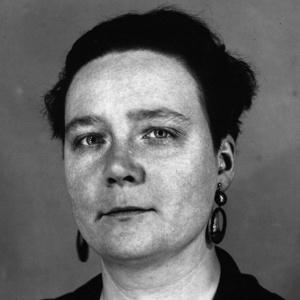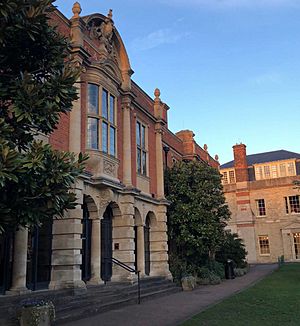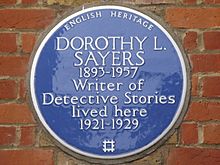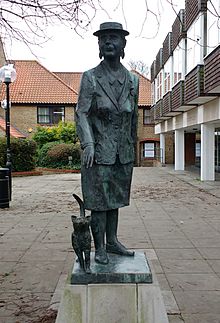Dorothy L. Sayers facts for kids
Quick facts for kids
Dorothy L. Sayers
|
|
|---|---|
 |
|
| Born | 13 June 1893 Oxford, England |
| Died | 17 December 1957 (aged 64) Witham, Essex, England |
| Occupation | Novelist, playwright, poet |
| Language | English |
| Nationality | English |
| Alma mater | Somerville College, Oxford |
| Genre | Crime fiction |
| Literary movement | Golden Age of Detective Fiction |
| Spouse |
Oswald Atherton "Mac" Fleming
(m. 1926; died 1950) |
| Children | 1 |
Dorothy Leigh Sayers (born June 13, 1893 – died December 17, 1957) was a famous English writer and poet. She was also very good at studying old and new languages.
She is most famous for her mystery novels and short stories. These stories are set between the First and Second World Wars. They feature a smart English aristocrat and detective named Lord Peter Wimsey. Dorothy L. Sayers was one of the top crime writers during the "Golden Age of Detective Fiction". People called her one of the four "Queens of Crime", along with Agatha Christie, Margery Allingham, and Ngaio Marsh.
Sayers also wrote many plays, literary reviews, and essays. She believed her best work was translating Dante's famous poem, Divine Comedy. When she passed away in 1957, The New York Times said that many critics thought her mystery novel The Nine Tailors was her greatest book.
Contents
About Dorothy L. Sayers
Early Life and School

Dorothy Sayers was an only child. She was born on June 13, 1893, in Oxford, England. Her parents were Helen Mary Leigh and Reverend Henry Sayers. Her father was a chaplain at Christ Church Cathedral, Oxford, and headmaster of Christ Church Cathedral School.
When Dorothy was six, her father started teaching her Latin. She grew up in a small village called Bluntisham. Her father became the rector (a type of church leader) there. The church graveyard in Bluntisham has surnames that appear in her mystery novel The Nine Tailors. She was inspired by her father fixing the church bells in 1910. The nearby River Great Ouse and the Fens (a marshy area) are similar to the big flood described in her book.
From 1909, Sayers went to the Godolphin School, a boarding school in Salisbury.
In 1912, Sayers won a special scholarship to Somerville College, Oxford. There, she studied modern languages and old literature. She finished with top honors in 1915. At that time, women did not officially get degrees from Oxford. But Sayers was among the first women to receive a degree when the rules changed a few years later. In 1920, she earned her MA degree. Her experiences at Oxford later inspired her novel Gaudy Night.
Her Work
Writing, Teaching, and Ads
Sayers's first book of poems, OP. I, was published in 1916. Her second book of poems, "Catholic Tales and Christian Songs", came out in 1918. Later, Sayers worked for a publisher and as a teacher in different places, including France. She also published poems in The Oxford Magazine. In 1920, she contributed two poems to The Quorum.
In the early 1920s, she worked for a publisher named Victor Gollancz.
Sayers's longest job was from 1922 to 1931. She worked as a copywriter (someone who writes advertisements) at S.H. Benson's advertising agency in London. She helped create famous ads like "The Mustard Club" for Colman's Mustard and the Guinness "Zoo" advertisements. Some of these ads are still seen today!
Detective Stories
Sayers started planning her first novel around 1920–1921.
Her detective character, Lord Peter Wimsey, appeared in eleven novels and two collections of short stories. Sayers once said that Lord Peter was a mix of a dancer like Fred Astaire and a funny character like Bertie Wooster. She introduced the character of Harriet Vane, a detective novelist, in Strong Poison. Sayers often said she created Harriet to help Lord Peter settle down and get married. But as she wrote Gaudy Night, she found Lord Peter and Harriet became so real that she couldn't make Lord Peter leave the story.
She also co-wrote a mystery novel without Wimsey, The Documents in the Case, with Robert Eustace. She also helped write parts of three other mysteries with members of the Detection Club.
Sayers's detective stories often explored important topics. The Unpleasantness at the Bellona Club looked at the difficulties faced by World War I veterans. Murder Must Advertise discussed the rules of advertising. Gaudy Night supported women's education and their role in society, which was a debated topic then. In Gaudy Night, a character writes a book against the Nazi idea of "Kinder, Küche, Kirche" (children, kitchen, church), which limited women's roles. This novel is seen as a challenge to those ideas. It has even been called "the first feminist mystery novel." Sayers's Christian beliefs and academic experiences are also themes in her detective series.
Sayers also wrote eleven short stories about Montague Egg. He was a wine and spirits salesman who solved mysteries. Six of these stories are in her book Hangman's Holiday (1933), and the other five are in In the Teeth of the Evidence (1939).
Translating Books
Sayers herself thought her translation of Dante's Divine Comedy was her best work. The first part, Hell, came out in 1949. Purgatory followed in 1955. The third part, Paradise, was not finished when she died. It was completed by Barbara Reynolds in 1962.
Sayers's translation kept the original Italian rhyme style. For example, the famous line "Abandon all hope, ye who enter here" became "Lay down all hope, you who go in by me" in her translation. This helped her keep the rhymes and rhythm of the original poem.
Her translation of the Divine Comedy includes many notes at the end of each section. These notes explain the religious meaning of what she called "a great Christian allegory." Her translation is still very popular today.
She also admired the old French poem Roland because it was a purely Christian story. She felt it was different from other old poems like Beowulf, which had strong pagan (non-Christian) elements.
Christian Writings and Ideas
Sayers's religious book The Mind of the Maker (1941) explores the idea that human creators (like writers) are similar to the Christian idea of the Trinity (Father, Son, and Holy Spirit) in creation. She suggests that any important human creation involves an Idea, the Energy (the process of creating), and the Power (the effect it has on others). She compares this "trinity" to the theological Trinity. The book includes examples from her own writing experiences.
Creed or Chaos? is another of her religious books. It explains basic Christian beliefs, similar to C. S. Lewis's book Mere Christianity. Both writers wanted to explain the main ideas of Christianity clearly to people who might have misunderstood them.
Her important essay "The Lost Tools of Learning" has been used by many schools in the US. It helped start the classical education movement, which brings back medieval subjects like grammar, logic, and rhetoric. Sayers also wrote three books of notes about Dante, religious essays, and several plays. The Man Born to Be King is one of her most famous plays.
Sayers's religious works were so good at explaining Anglican (a type of Christian) beliefs that in 1943, the Archbishop of Canterbury offered her a special doctorate in divinity. She politely declined, saying she served "Divinity, as it were, accidentally, coming to it as a writer rather than as a Christian person." In 1950, she accepted an honorary degree from the University of Durham.
Her Beliefs
Women's Rights
Sayers did not like to be called a feminist. She said, "I am afraid—that I was not sure I wanted to 'identify myself,' as the phrase goes, with feminism, and that the time for 'feminism,' in the old-fashioned sense of the word, had gone past." However, she still spoke out against unfairness caused by gender differences. In her essay Are Women Human?, she explained that feminism should not be about saying "a woman is as good as a man" or trying to "copy what men do." Instead, she believed that equality should be based on recognizing that all people are human beings, regardless of gender.
Sayers continued this idea in her essay The Human-Not-Quite-Human. In this essay, she made fun of gender stereotypes by reversing them.
What She Thought About Feminism
Gaudy Night has been called "the first feminist mystery novel." This book talks a lot about feminist ideas. Even though Sayers didn't like the label "feminist," she preferred to be seen as "simply human." Many experts still consider her a feminist because she actively supported women's rights.
Her Personal Life

An Early Relationship
In 1920, Sayers had an intense relationship with a poet named John Cournos. This relationship later inspired her character Harriet Vane in her novels. Cournos is shown as the character Philip Boyes in her novel Strong Poison.
Her Son, John Anthony
In 1923, Dorothy Sayers had a son named John Anthony. He was raised by her aunt and cousin, Amy and Ivy Amy Shrimpton, and was introduced to family and friends as her nephew. In 1935, John Anthony was legally adopted by Sayers and her husband, "Mac" Fleming. Sayers stayed in close contact with her son and made sure he received a good education. John Anthony later won a scholarship to Balliol College, Oxford, which was the same college Sayers chose for her character Wimsey.
Marriage to "Mac" Fleming
After publishing her first two detective novels, Sayers married Captain Oswald Atherton "Mac" Fleming. He was a Scottish journalist. They got married on April 13, 1926. Fleming had two daughters from a previous marriage.
Sayers and Fleming lived in a small flat in London. Fleming worked as a writer and journalist, and Sayers continued as an advertising copywriter and author. Over time, Fleming's health got worse, partly because of his service in the First World War. This made it difficult for him to work.
Later Years and Legacy
Fleming passed away on June 9, 1950.
Dorothy Sayers died suddenly on December 17, 1957, at the age of 64. Her ashes were buried under the tower of St Anne's Church, Soho, London, where she had been a churchwarden for many years. After her death, it was publicly shared that John Anthony, who everyone thought was her nephew, was actually her son. He was the only person to inherit from her will.
John Anthony, Sayers's son, died on November 26, 1984, at age 60. He had been married twice and had two children from his first marriage.
Sayers is remembered with a special plaque in Kingston upon Hull.
Friendships
The Mutual Admiration Society
Sayers was part of a writing group called The Mutual Admiration Society (MAS) while she was a student at Somerville College, Oxford. Sayers started the MAS in 1912 with two other students. It was a group for women writers to read and give feedback on each other's work. Sayers jokingly named the group "Mutual Admiration Society."
The MAS created one special book of writings called The Blue Moon. It had six pieces, including three poems and a short story by Sayers.
This group gave its female members a safe place to share their writing and support each other in Oxford, which was mostly a male-dominated environment. They stayed in touch for many years after college.
There were 9 known members of the MAS, including Dorothy L. Sayers. Many of these women became "vibrant women, prolific authors, theatrical figures, social activists, teachers, and scholars."
Friendship with the Inklings
Sayers was a friend of C. S. Lewis and some other writers known as The Inklings. Sometimes, Sayers joined Lewis at meetings of the Socratic Club. Lewis said he read Sayers's play The Man Born to Be King every Easter. J. R. R. Tolkien read some of her Wimsey novels but did not like the later ones, like Gaudy Night.
C. S. Lewis
Sayers's friendship with C. S. Lewis began when she wrote him a fan letter about his Christian book, The Screwtape Letters. Lewis later said she was the first important person to ever send him a fan letter. He wrote back, praising her play The Man Born to Be King. They wrote many letters to each other, discussing their writing and academic interests. They gave each other feedback and encouragement.
Even though they were friends and shared interests in writing and religion, they had some disagreements. For example, Lewis was against women becoming priests in the Church of England. He asked Sayers to speak out against it, but she refused. She wrote back that she couldn't find any religious reason to oppose it.
Sayers also commented on Lewis's views on women in another letter. She said, "I do admit that he is apt to write shocking nonsense about women and marriage. (That, however, is not because he is a bad theologian but because he is a rather frightened bachelor.)”
G. K. Chesterton
Sayers was greatly influenced by G. K. Chesterton. He was also a detective fiction writer, essayist, and critic. Sayers said, "I think, in some ways, G.K.’s books have become more a part of my mental make-up than those of any writer you could name.” She knew Chesterton's writings from when she was young and attended his lectures at Oxford. They became friends in 1917 after she became a published author.
The Detection Club
Sayers, along with Chesterton, helped start the Detection Club. This was a group for British mystery writers. Chesterton was the first president, and Sayers was the third (from 1949–1957).
Her Legacy
Sometimes, the character Harriet Vane in Sayers's books makes fun of the mystery genre itself, even while following its rules.
Other writers often made fun of Sayers's work in a playful way. Edmund Clerihew Bentley, who wrote an early detective novel, wrote a parody called "Greedy Night" (1938).
Sayers helped found and was an early president of the Detection Club. This group of detective novel writers had a unique initiation ceremony that Sayers created. The Club still exists today and continues to use this ritual. In Sayers's time, members of the club would sometimes write collaborative detective novels. They would each write one chapter without knowing what the others were writing.
Sayers's characters, and Sayers herself, have appeared in other books:
- Jill Paton Walsh wrote four more novels about Peter Wimsey and Harriet Vane.
- Dorothy Sayers is mentioned by Agatha Christie in her novel The Body in the Library.
- Wimsey appears in C. Northcote Parkinson's funny novel Jeeves.
- Wimsey also has a small appearance in Laurie R. King's A Letter of Mary, a book about Sherlock Holmes.
- Sayers appears with Agatha Christie as a main character in Dorothy and Agatha, a mystery novel by Gaylord Larsen.
A house at Christ Church Cathedral School is named after her. The Sayers Classical Academy in Kentucky, USA, is also named after her.
A small planet, 3627 Sayers, is named after her.
In 2022, Sayers was officially added to the Episcopal Church liturgical calendar. Her feast day is on December 17.
Works
See also
 In Spanish: Dorothy L. Sayers para niños
In Spanish: Dorothy L. Sayers para niños


